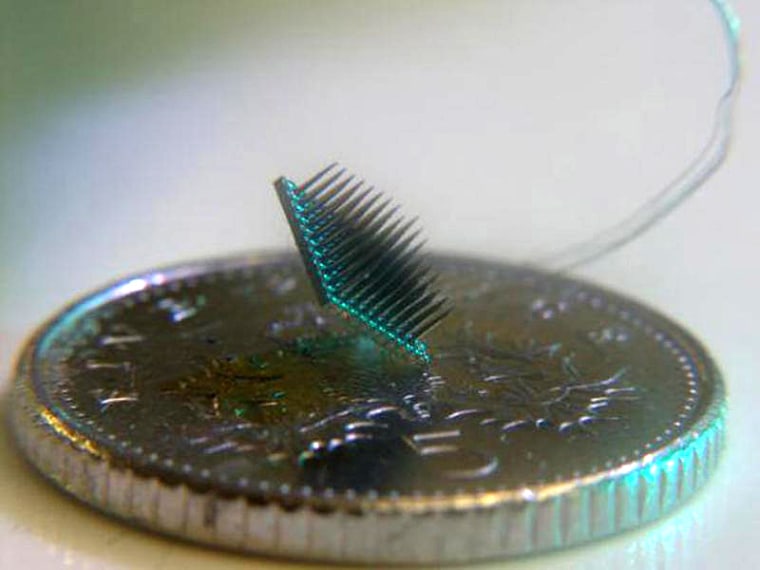The era of merging our minds with technology has begun. Already, we can hack the brain to treat diseases such as Parkinson’s or help paralyzed people move again. But what if you could install a chip in your head that would not only fix any health issues, but could amp up your brainpower — would you remember every word said during a meeting, finish crossword puzzles faster, drive better thanks to enhanced senses, or pick up a new language before your next trip?
That’s the future envisioned by Elon Musk, the Tesla and SpaceX CEO who recently announced Neuralink, a new company dedicated to blending human brains with computers. In Musk's view, we’ll have to keep pace with ever-smarter artificial intelligence by implanting a “neural lace,” or sci-fi inspired machine interface that will make us smarter.
“Under any rate of advancement in AI, we will be left behind by a lot," Musk said last year. "The benign situation with ultra-intelligent AI is that we would be so far below in intelligence we’d be like a pet, or a house cat.”

Super-smart AI isn’t right around the corner, and Musk’s goal of creating brain implants for healthy people in just eight to 10 years might not be realistic. But scientists are hard at work on technology that could boost our mental skills. Some of these gadgets could be worn right on the skin, but the most powerful ones will be nestled in the brain. Here’s how they might work.
Making Contact
The first steps towards using computers to upgrade our mental skills will be improving the connection between brains and machines. Initial developments will beef up our senses and allow us to control robots from a distance, says Kevin Warwick, an emeritus cybernetics professor at Coventry University and Reading University in the United Kingdom.
Technology that can use the electrical signals crackling through our nervous systems to help command computers already exists in some form. People with severe paralysis can use brain-computer interfaces to control a cursor on a screen. Others have been able to move robotic limbs or fly planes.
Researchers can also use the technology to deliver messages to the brain. By sending an electric current into the correct neurons, scientists have been able to restore a person’s sense of touch or hearing, treat tremors caused by Parkinson’s, or send very simple signals from one brain to another.
Researchers are now exploring whether these technologies could also sharpen certain cognitive skills. One non-invasive technique called transcranial direct current stimulation works by sending electricity through the scalp. Some scientists (and DIY brain hackers) hope it can help improve skills like learning and memory. But it’s not clear yet if this brain-zapping technology is effective.
Meanwhile, the Defense Advanced Research Projects Agency (DARPA) is investigating a less direct approach: sending electrical pulses into the body. Research indicates that zapping certain peripheral nerves — which connect the brain and spinal cord to the body — may help people learn skills faster. The most promising target for this approach is the vagus nerve, which passes through the neck.
“This is the information superhighway carrying information from the body to the brain,” says Doug Weber, program manager for DARPA’s Targeted Neuroplasticity Training program.
Related: This Revolutionary Gene-Editing Tool Could Change the World
Sending electricity through the vagus and other nerves may prompt the brain to release chemicals that alter connections between different neurons. This is already a key part of our learning, but by using a machine to rev up this natural process, people might be able to “tune” their brains to recognize important details with less practice.
“If we can enhance that training process... then perhaps foreign language experts can be trained more quickly to recognize very unfamiliar sounds,” Weber says. He and his colleagues are hoping to develop a non-invasive gadget that would be safe and effective enough for anyone to use.
Implanting electrodes inside a human brain is still risky, so it's only done to treat neurological diseases. However, non-invasive technology can’t zero in on the exact neurons it would need to stimulate to really boost someone's mental skills. For that, scientists will need to come up with technologies that can be embedded inside our skulls.
“At that level you gain access to the actual source code of the brain — our neurons that are firing,” says Bryan Johnson, founder and CEO of the neuroscience startup Kernel, which like Neuralink is working on brain implants to boost cognition. “That’s the entry point you gain the highest potential of what you can do.”
Part of Us
How these surgeries might become outpatient procedures remains to be seen. Eventually, it could be automated like laser eye surgery, Musk mused during a conversation with the site Wait Buy Why. But whatever we put inside the brain, it will have to be more sophisticated than today’s technology.
At first, it might look a bit like today’s brain-computer interfaces. Many, such as BrainGate, use a pad with dozens of needle-like electrodes to plug into the brain. “That is really a bit like a mini hairbrush,” Warwick says. We might adapt this kind of design for implants that would be slipped into different areas beneath the skull.
“Probably it would be many implants first, aiming towards a single implant with many electrodes,” Paul Zehr, a neuroscientist at the University of Victoria in British Columbia, said in an email. These implants might initially be the size of a smartwatch, he speculates.
Related: Three Myths About the Brain (That Deserve to Die)
Or we might take another approach, like injecting nano-sensors that would be deployed throughout the brain and controlled by magnets or radio signals, Zehr says. Some scientists are looking into out-of-the-box interfaces made from silk or electrode arrays printed in a tattoo.
“Right now we’re really limited by the ways we’re recording and stimulating cells in the brain,” Zehr says.
A brain implant might work by sending pulses of electricity directly into neurons that help govern a particular skill, he says, although how this will boost performance isn't clear. Or the chip might be a more powerful version of DARPA’s technology that would tinker with the chemicals the brain uses to help itself learn.

Or the chip might give the brain some extra memory and processing power, so recollections and knowledge could be stored externally rather than forgotten. “Downloading” memories directly into the brain is definitely a long way off, though, Warwick says.
There’s no one area of the brain an implant could zap to make us more intelligent across the board. We’ll have to target specific skills. Abilities that rely on the senses (like picking up a new language) will be the most straightforward to enhance. We could also sharpen our focus relatively easily, Zehr says.
Eventually, we could target other abilities, like reasoning, creativity, willpower, or judgment. However, these skills are powered by many brain areas working together, so figuring out how to improve them will take longer.
This is Your Brain on Computers
So what happens if we do merge with machines — or at least use them to make ourselves smarter? Who would be able to use cognitive enhancement technology? How much might it cost? How would we make sure the technology feeding into our minds stayed private and secure?
We can’t fully imagine how we might use a new tool until it’s in our hands (or brains). No one could have guessed all the ways we would use the Internet, or the knowledge we would gain from all the books made available by the invention of the printing press, Johnson points out.
Related: Could These Tiny Devices Make Smartphones Obsolete?
In the meantime, we have plenty to appreciate about our brains. Sure, the human mind has its limitations; there’s only so much we can learn and remember. But we have the brain, with its billions of information-ferrying neurons, to thank for our ability to read a book, learn a recipe, feel compassion for others, navigate websites — and dream up technology to make us even cleverer.
“The brain is the master tool and the master of all tools,” Johnson says. “Everything we are, everything we do, everything we’re capable of is because of our brain.”
